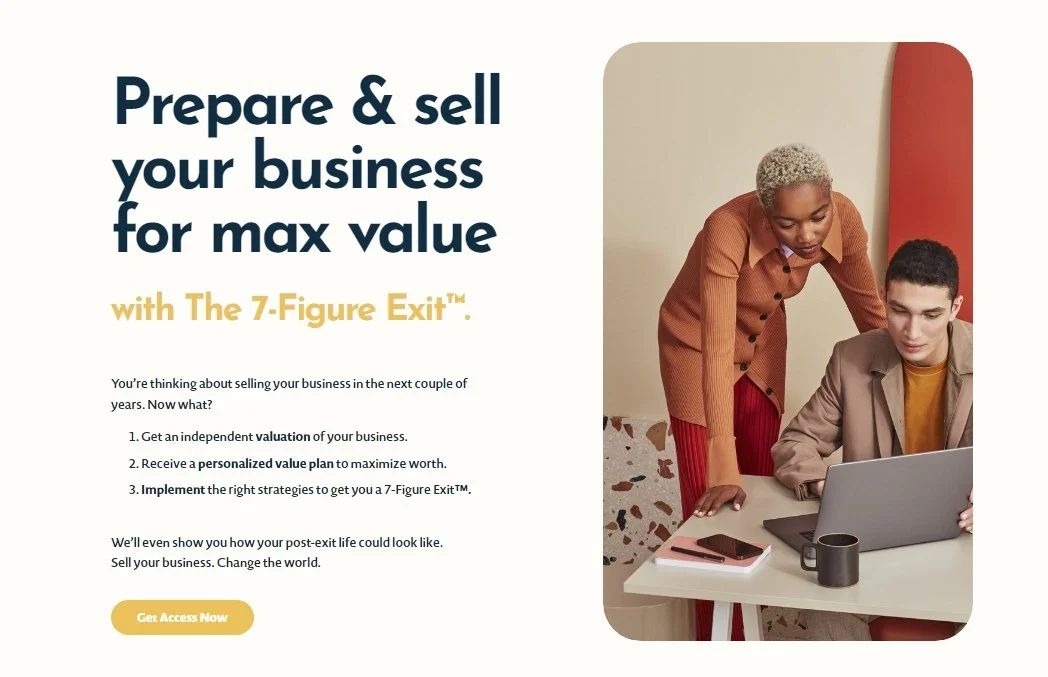Biggest Mistake Founders Make When Building a Business
Many business owners work hard to grow their businesses, but often forget to plan for the day they might want to sell. This can cause problems down the line. Did you know that less than 10% of small business owners succeed in selling their business, mostly because they had a good plan for exiting?
In this blog post, I'll show you how to avoid this problem, and make sure your business is sellable and valuable.
How to Build Your Business with Selling in Mind
Make Your Operations Work Without You
Build a Brand That Doesn't Rely on You
Keep Your Finances Healthy
Step 1: Make Your Operations Work Without You
Buyers want a business that can run without its owner. This means having clear systems and processes in place that your team can follow. “If you are the fulfillment, no one wants to buy your business.” Nathan Hirsh, who founded and sold FreeeUp.
Expert Tips:
Write down every step in your business, from taking on new clients to everyday tasks, in a standard procedure. Every procedure should be clearly described, quick to find and easy to follow.
Use tools to automate the tasks that are done over and over again. This saves time and reduces mistakes.
Make sure your team can run the business without you. Your business shouldn't rely on just one person. When you take a few weeks of vacation, your business shouldn’t miss a beat.
Leona Watson’s Story:
Business owner Leona Watson explains “you need to take yourself out of your business”. She did this by exercising in the morning and not going to the office till noon. This resulted in her “no longer being a distraction to the team”. Then she created procedures instead of “constantly winging it, and then wondering why your team is constantly bothering you with easy-to-answer questions”. The business moved from being in her head, to being in a document that others could use.
Your Action Step:
Every week, spend an hour writing down 3 processes in your business that you can delegate to your team or automate.
Extra resource:
Here’s one of my best read blog posts on how I scaled my services beyond me.
Step 2: Build a Brand That Doesn't Rely on You
Small businesses often rely heavily on their owners for sales and marketing. But, when you want to sell, your face can’t be the brand of the business. Like Michael Hyatt, who recently rebranded his company from ‘Michael Hyatt’ to ‘Full Focus’. “The company has grown beyond my name,” he explains the name change. “I'm proud of where we've been and excited about where we're headed. With our commitment to continuous growth, this is the natural next step to even greater company success.”
Expert Advice:
Create a brand that's separate from you. This can include things like using product names, rather than your personal name in all your marketing channels, like website, social media, brochures,...
Show off your team and their skills in your marketing materials. This helps shift the focus from you to the whole business.
Make sure your customers keep coming back because the business is good, not just because they like you.
Photographer Sue’s Story:
Sue Bryce built a $1M business around her unique photography skills. She always thought about how she could separate herself from her business. She shared a quote in a recent podcast interview that made a big difference in her business: "I am not that important."
Your Action Step:
Reflect on Sue’s quote this weekend when thinking about your business brand. How is it still tied to your personal brand? Write down one way you can make your business look more independent.
Extra resource:
Here’s my 3-step guide on how to shift from personal to business brand.
Step 3: Keep Your Finances Healthy
Your business needs to be financially healthy to be sellable. Buyers want a business that's profitable, has clean financial records, and can grow.
Expert Tips:
Keep your financial records clean and up-to-date. Use accounting software to accurately track your income and expenses.
Focus on profitability, not just revenue. High revenue doesn't mean much if your profit margins are low.
Regularly check your financial statements to spot problems early and make sure your business can sustain itself.
Your Action Step:
Next time you sit down with your accountant, plan some extra time to review your financial records. Are they clean and up-to-date? Look for areas where you can save money or be more efficient, so you can increase profitability. You will be surprised how many subscriptions or licenses you pay for that no one in your team uses.
How You can Build to Sell
Now, it’s your turn! Follow these steps to make sure your business is built to sell:
Document one process in your business this week.
Decide on one way to make your brand less dependent on you.
Review your finances and find one area to improve.
Reflect on these tasks and see how they can help transform your business into a sellable asset.
Conclusion
Building a business to sell isn't just about the end goal of an exit; it's about creating a robust, independent, and profitable business. By following these steps, you can ensure your business is attractive to potential buyers. Remember, the biggest mistake business owners make is not building to sell. Avoid this mistake and set your business up for your big exit.


